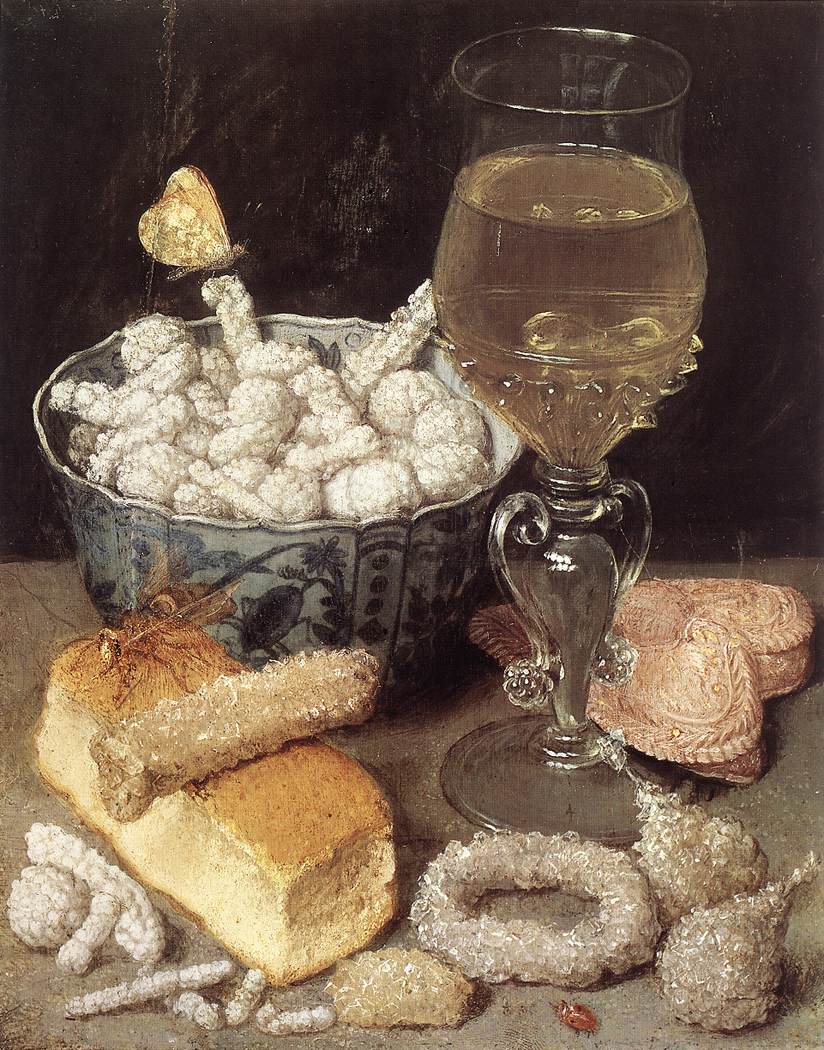|
FLEGEL, Georg/ ARTISTS
BEFORE 1650/ MAIN ART
|
home
|
|
(b. 1566,
Olomouc, d. 1638, Frankfurt am Main)
German painter. He acquired citizen’s rights
in Frankfurt in 1597 and stayed there until he died. He worked a lot
together with the Fleming Lucas van Valckenborch. Flegel is considered
to be the most important representative of early modern German still-lifes.
He specialised in so-called meals, banquet, breakfast and flower still-lifes.
|
film and food
|
|
literature
and food
|
|
music
and food
|

|
|
photography and food |
|
Die Aquarelle
von Georg Flegel Amazon.de
|
|
Georg Flegel. 1566 – 1638.
German
food
|
Still-Life with Bread and Confectionary
Oil on wood, 21,7 x 17 cm
Städelsches Kunstinstitut, Frankfurt
|
|
|
In the culinary culture
of the aristocracy and the patrician middle classes, banquets consisted
of six to eight – sometimes even nine – courses and were always
concluded by a dessert. Interest in desserts came to a climax at a time
when numerous delicacies had been introduced as new luxuries. This was
especially true for sugar confectionary, which appeared in still-lifes
around 1600 for the first time. The introduction of sugar marked a
radical revolution of taste. Initially it was only used for
pharmaceutical purposes, but it soon replaced honey as a sweetener and a
food.
The crystalline structure
of the candied sugar was rendered especially accurately by Georg Flegel
in his confectionary still-life. His painting shows candied fruit on a
table in the foreground, including two figs on the right, encrusted with
large sugar crystals. Some of the fruits have been cut up in the shape
of letters, for example a large ‘O’ can be made out as well as a
crumbled ‘A’ beside the loaf of bread. A straight piece of sugar is
lying across the loaf like a cross-beam and is being approached by a
disproportionately large bee. The earthenware bowl with the blue pattern
contains candied fruit dusted with icing sugar, and a brimstone
butterfly, whose wings also show traces of sugar, has alighted on it.
Flegel added a religious
dimension, because the seemingly innocuous arrangement is full of
Christian allusions. For example, the letters ‘A’ and ‘O’ (Alpha and
Omega) as the first and last letters of the Greek alphabet are a
reference to Apocalypse 1:8 and 21:6, where Christ is referred to as the
beginning and the end. The cross formed by the loaf and the piece of
sugar emphasizes this aspect even further. Finally, as a reminder of the
Eucharist, there is the bread and wine in the dainty glass, with
decorations resembling amphora handles which drop down in the form of
grape-like clusters at the bottom. The redemptive work of Christ is
called to mind by the butterfly, an ancient symbol of the human soul as
well of the resurrection, as new life comes forth from a seemingly dead
chrysalis. The heart on the right is a specially shaped piece of bread,
made from communion wafer dough, and is apparently meant to remind the
viewer of the heart of Christ.
In Flegel’s art, sugar
has entirely taken over the religious connotations of honey, which was
understood as a symbol of ‘spiritual sweetness’ during the Middle ages.
|
|
|
|
|
|

|
|
|
Still-life with Parrot
Oil on copper, 78 x 67 cm
Alte Pinakothek, Munich
|
|
|
The very Netherlandish-looking bouquet of
flowers with tulips, carnations, roses and narcissi, is as superbly
painted as the silver vase ornamented with golden mascarons in which it
has been placed. The different qualities of silver, gold and pewter,
their various degrees of brilliance, hardness and finish have been
rendered in painstaking detail. The heavy pewter plates are juxtaposed
with an elegant, fine-rimmed silver dish and a golden-lidded chalice
bearing a fine statuette of Mars. The blade of the knife at the edge of
the table, the dish of hazelnuts, the lid and edge of the brown
earthenware jug – all are variations on the artist’s theme.
The display of foodstuffs seems less
impressive at first glance, and arranged almost at random. Everything
seems to be arranged by pure chance, so much so in fact that an
allegorical interpretation seems unlikely. Though the composition may
appear purely cumulative, it is nevertheless precisely calculated,
especially in the masterly distribution of colour highlights.
|
|
|